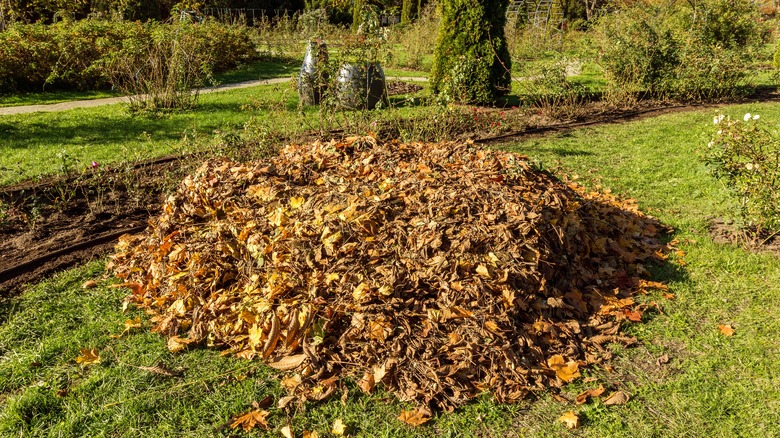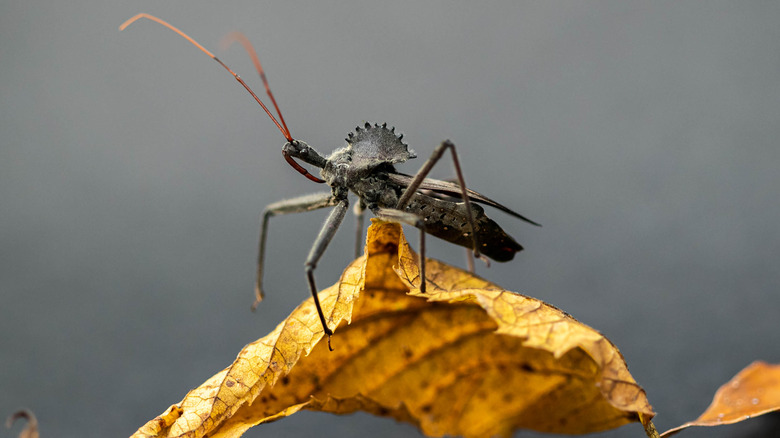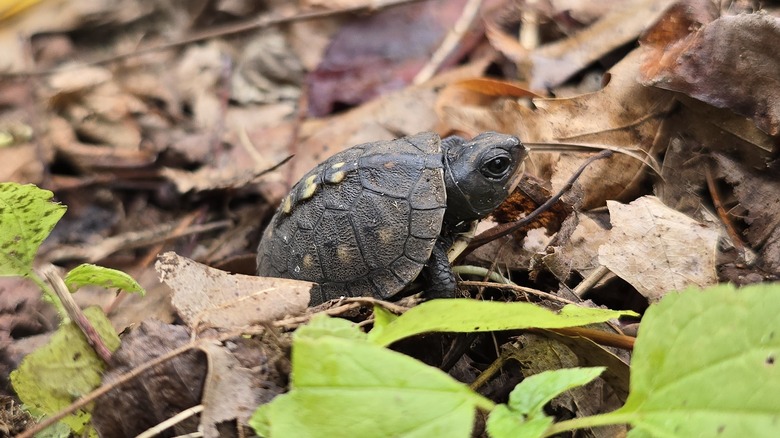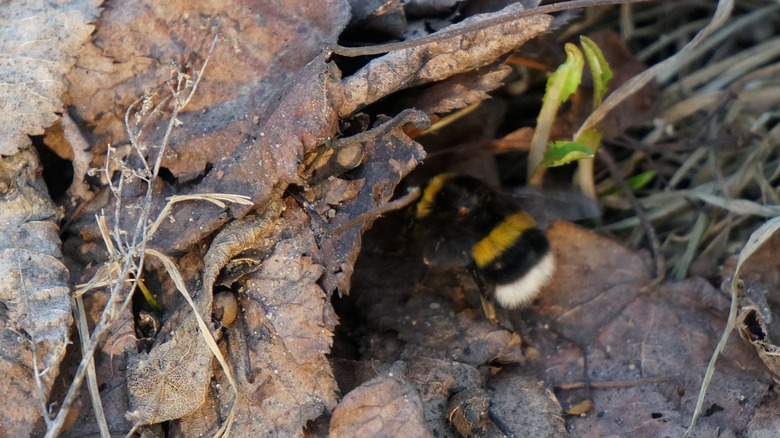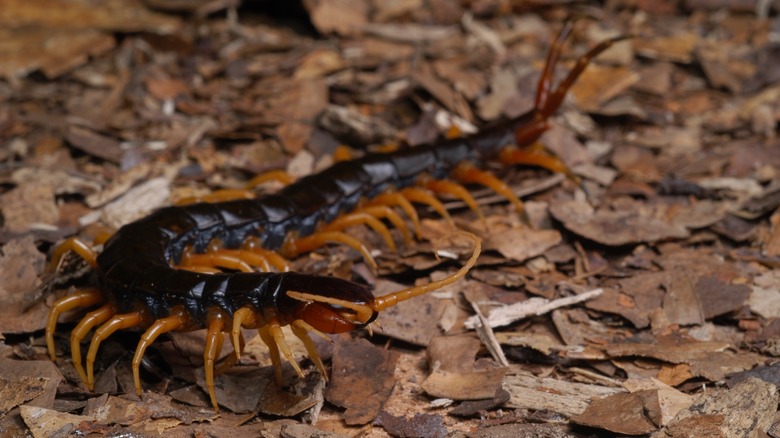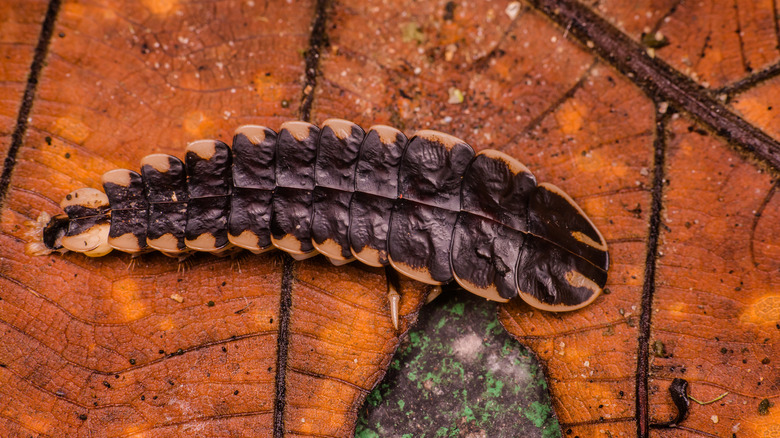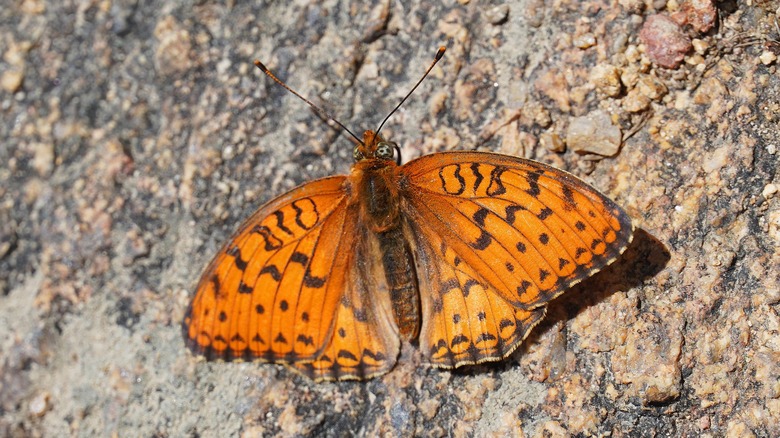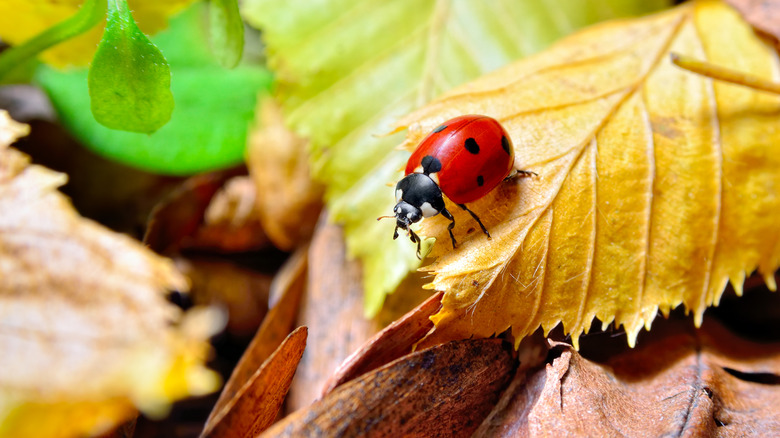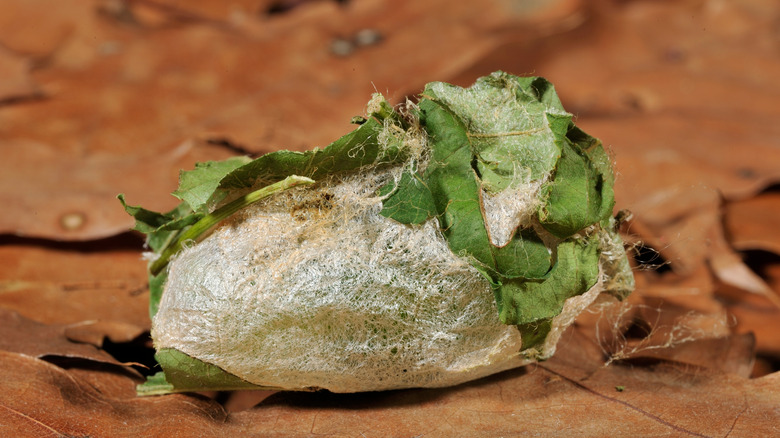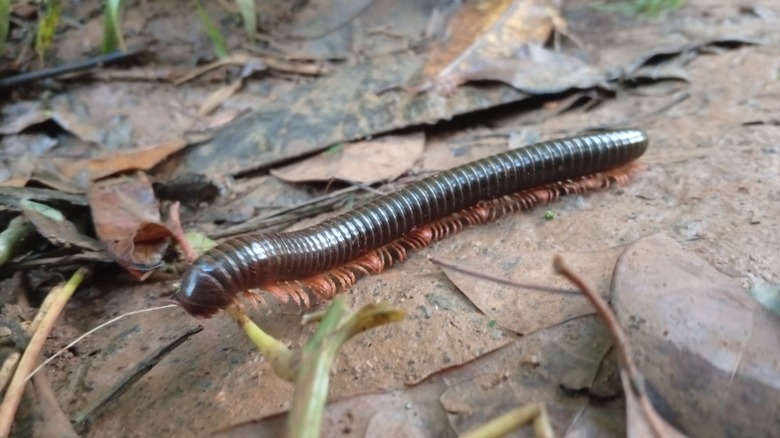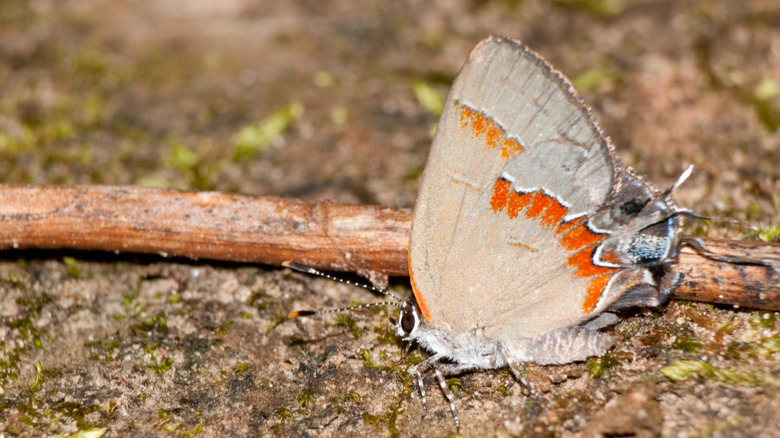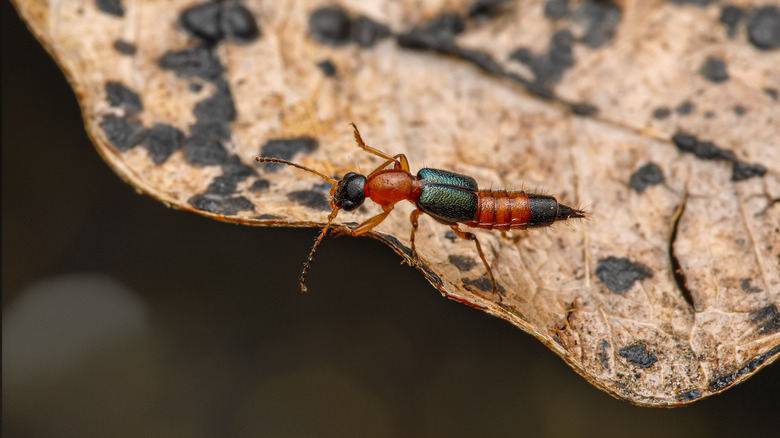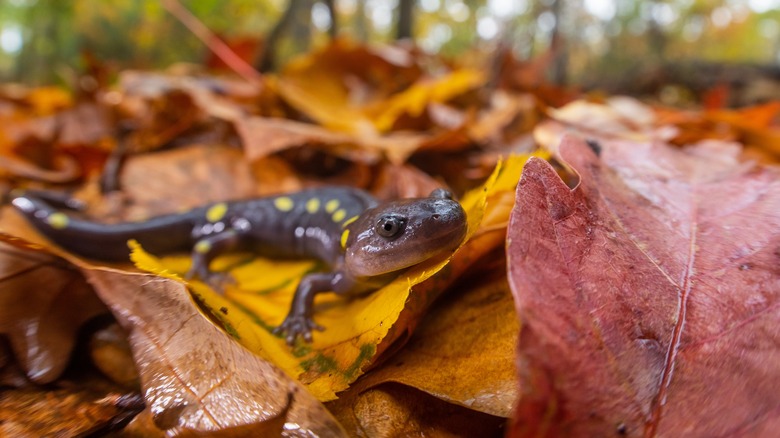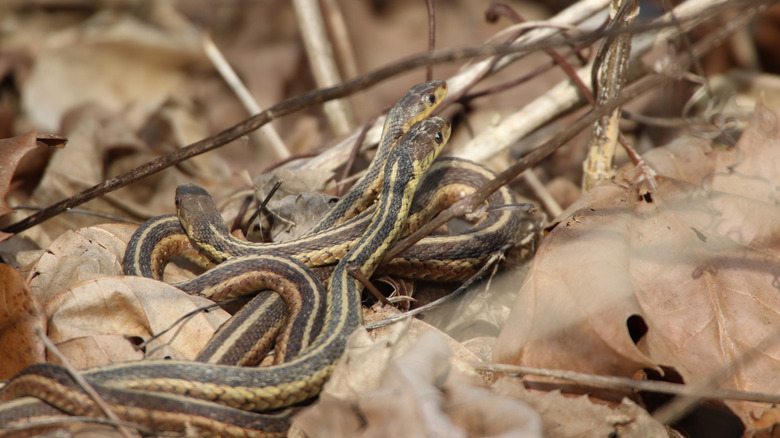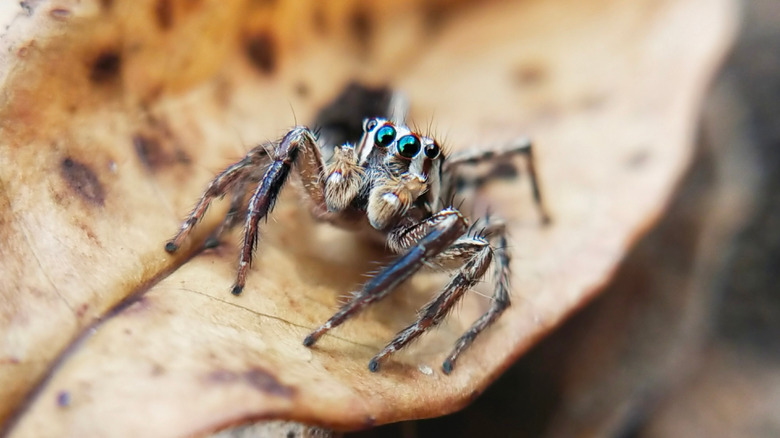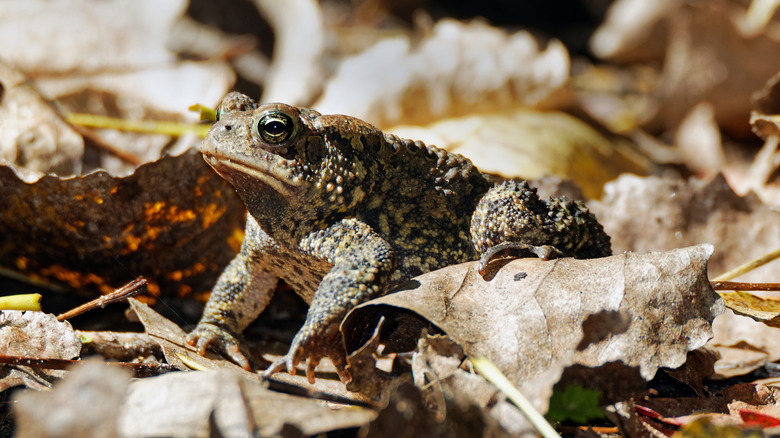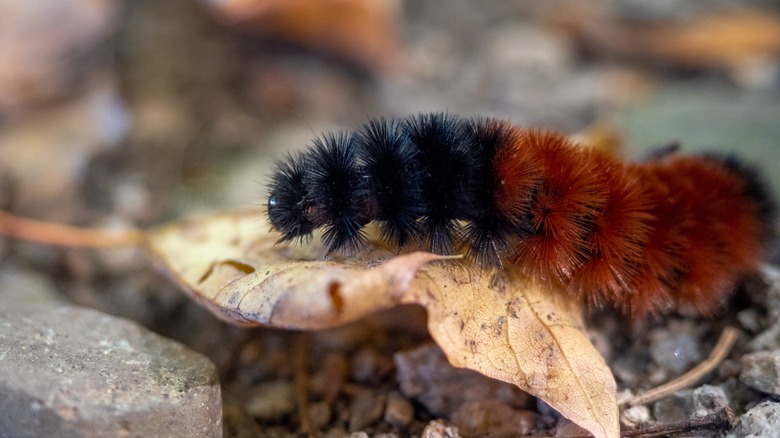16 Beneficial Creatures That Are Attracted To The Leaf Piles In Your Yard
If one of your family's favorite autumn traditions is freefalling onto a pile of leaves, you may want to pause and consider the critters that may be holed up inside. It may look like yardwork to us, but to the creatures that live outdoors, a pile of leaves is a place to call home. When you rake or blow leaf litter into a mound, the pile will contain many creatures that live their natural lives in this layer. If left to sit, the piled leaves will then attract additional critters. Take a dive into the pile and you may end up landing on a centipede, salamander, or snake.
While we might risk being startled at coming eye to eye with a critter, or even getting bitten if we bump up against the wrong animal, for hidden wildlife there are dangers when we rake up the fallen leaves in our yards. Before you decide to shred, mow, burn, or bag your leaf pile, you now have the chance to learn about the beneficial creatures that make leaf litter their homes and decide if there's a better option for your pile of leaves. If you're worried about leaf piles introducing pests, know that leaving fallen leaves in your yard won't attract bugs into your home if you are strategic with the leaf litter. After becoming acquainted with these critters, rather than getting rid of the leaves, you may want to direct the fallen leaves into natural areas such as underneath trees.
Assassin bugs
Named for their habit of ambushing their prey, assassin bugs hunt on the plants in our yards, counting aphids and grasshoppers among their favorite foods. Making them beneficial creatures in the eyes of many gardeners, assassin bugs also eat Japanese beetles and Colorado potato beetles, both of which are common pests attracted to our garden plants. These beneficial insects hiding in your leaf pile are there to take shelter from the cold conditions of winter.
Box turtles
Box turtles are beneficial creatures that play integral roles in the ecosystem, acting as both prey and predator. Their diets include slugs, among other things such as insects. These turtles are attracted to leaf piles for shelter and to protect themselves from predators. The leaf litter in your yard can help insulate turtles from cold winter temperatures while they are brumating, which is a type of hibernation.
Bumble bees
Bumble bees are one of the unexpected beneficial creatures you might find attracted to your leaf pile. These beneficial insects help pollinate crops like tomatoes and peppers, and are crucial to pollinating many other types of plants as well. Leaf litter offers bumble bee queens a place to hibernate for the winter, making leaving the leaves an important wildlife-friendly step to take in your yard.
Centipedes
With flattened bodies and up to 30 pairs of legs,centipedes are arthropods that sometimes show up inside our homes. Outdoors they are attracted to leaf litter, where they hunt insects or earthworms, so they may end up in that leaf pile in your yard too. These beneficial creatures also help control pests we might not want to have around, such as cockroaches.
Fireflies
Everyone loves seeing fireflies in their yards, with their their flashing yellow lights. But not everyone realizes that leaf litter contains firefly eggs and larvae. Fireflies serve as both prey and predators in the food web, eating snails and slugs. Since everyone's a fan of these beneficial creatures, fireflies are also a flagship species to encourage nature conservation. Don't bag up your leaf pile, since keeping leaf litter around is one of the best ways to attract fireflies to your backyard, and it would be such a shame to throw away this life-filled natural mulch.
Great spangled fritillary butterflies
Leaving leaf litter in your yard is one of the ways to bring more pollinators into your yard and garden — including butterflies, such as the great spangled fritillary. These tan, orange, or dark orange colored butterflies have black or brown markings. The flowers these beneficial creatures help pollinate include coneflowers (Echinacea spp.), azaleas (Rhododendron spp.), and milkweed (Asclepias spp.). While you won't find the adult butterflies hiding in the leaf pile in your yard, their caterpillars are attracted to them, seeking protection from the cold among fallen leaves.
Ladybugs
Also known as lady beetles or ladybirds, lady bugs are easy to spot beneficial insects in our yards and gardens thanks to their bright coloring and distinctive markings. In the warm season, ladybugs busy themselves with feasting on pests such as aphids. For protection from winter these beneficial creatures are attracted to leaf litter as a source of cover, giving us a good reason not to bag or burn our leaf piles.
Luna moths
Another beneficial creature you might be surprised to find in your leaf pile — if you managed to recognize it there — is the luna moth. Moths such as luna moths are attracted to night blooming flowers, making them pollinators you should be happy to see in your yard. If you find a cocoon wrapped in leaves in your leaf litter, it might be a luna moth hibernating until springtime, when the moths will unfurl their gorgeous green wings.
Millipedes
Sift through your leaf pile and one of the arthropods you might see is a millipede, a beneficial creature with numerous legs and a long, rounded body. Millipedes are an important part of the food webs in our yards because they are attracted by the dead creatures and detritus that are part of leaf litter, helping with decomposition. In gardening circles, earthworms have a reputation as being excellent decomposers, but in some cases millipedes are even more effective at breaking down leaf litter than earthworms.
Red-banded hairstreaks
Another butterfly that is attracted to leaf litter as a necessary part of its lifecycle is the red-banded hairstreak, a type of butterfly that has brownish gray wings with a reddish orange lines. The survival of red-banded hairstreaks depends on the leaves in your leaf pile since these butterflies deposit their eggs on fallen leaves. These butterflies are beneficial creatures that feed on nectar from and help pollinate the milkweed, yarrow (Achillea spp.), and sumac (Rhus spp.) in our yards.
Rove beetles
One of the critters you might find attracted to your leaf pile is the rove beetle, a brown beetle with a narrow body. The rove beetle is a beneficial insect whose diet includes thrips, fungus gnats, and mealybugs — all of which are pests that gardeners would rather keep off of the plants in their yards. In addition to pest control, rove beetles perform another ecosystem service that makes them beneficial creatures – they help decompose dead things.
Salamanders
As we've seen, there are a lot of tiny critters living in leaf piles, and such arthropods serve as good food for other animals that are also attracted to leaf litter — such as salamanders. Salamanders are another one of the beneficial creatures that overwinter and hunt in fallen leaves in our yards, helping keep populations of insects like mosquitos in check. Salamanders are considered vital in their ecosystems, they help keep forests healthy, and may even have a beneficial effect on climate change.
Snakes
Since mounds of vegetation can be attractive as warm and cozy locations, snakes may be hiding in the leaf piles in your yard. Although you'll want to take care to avoid surprising one, you'll be happy to know that snakes provide multiple services in our yards. One of the biggest benefits of having snakes in your yard is their important role in keeping rodent populations at bay. With less rodents, these beneficial creatures even help to prevent the spread of rodent-spread diseases.
Spiders
If you sift through your leaf pile and look closely, you'll probably spot some spiders. Some spiders are attracted to leaf litter where they hunt and are in turn hunted. Spiders play an important role as beneficial creatures in our yards and gardens by helping keep insect populations under control — including pesky flies and mosquitos. Spiders are also an important source of food for wild birds. The leaf litter that we have raked up into a mound is actually important habitat for these residents of our yards.
Toads
Snakes aren't the only animals that think that leaf piles are warm and cozy, providing insulation from cold weather. Toads are also onto this wonderful phenomenon, and they are attracted to leaf litter as a place to take shelter during winter. These beneficial creatures eat slugs and snails, and doing so they help protect our gardens from damage. Having toads in our yards is also a sign of improved biodiversity. To help toads make it through the winter even more comfortably, you can fashion a toad abode with this sweet yard use for broken terra cotta pots.
Woolly bear caterpillars
Woolly bear caterpillars are one of the many types of butterflies and moths that hibernate during winter, surviving by insulating themselves in the leaf litter in our yards. A woolly bear caterpillar that was attracted by your leaf pile is waiting for spring to pass to come out and make its cocoon. When these beneficial creatures transform into Isabella tiger moths after they emerge from their cocoons, they contribute to the health of our landscapes by pollinating wildflowers.
